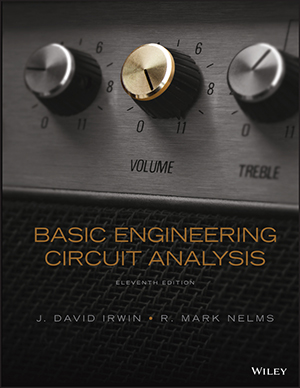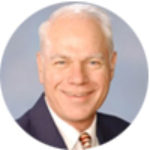
Basic Engineering Circuit Analysis, 11th Edition
By J. David Irwin and R. Mark Nelms
Basic Engineering Circuit Analysis by J. David Irwin and R. Mark Nelms is known for providing the most accessible presentation using a time-tested pedagogical structure that makes even the most intimidating material accessible to students. In this new Eleventh Edition, Irwin and Nelms have further developed the program’s pedagogical toolset to provide carefully “scaffolded” learning aids that help students make the connection between theory and practice.
Schedule a Demo Sign Up for a Test Drive Adopt WileyPLUSWant to learn more about WileyPLUS? Click Here
Learning Objectives
Each chapter begins with, and is structured around, specific learning objectives. Chapter openers feature new laboratory experiments that are associated with the learning objectives of the chapter.
Tools to help students build their problem-solving skills
Tools to help students build their problem-solving skills have been expanded to take full advantage of the combination of print and digital media. Key concepts are first described in text with illustrations, and followed by detailed example solutions. Additional problems and Learning Assessments are given with answers, but solutions are not provided. Most of the Learning Assessments are solved in detailed video tutorials featured in WileyPLUS.
Solved examples are available in supplements
Solved examples are available in supplements (available online) that apply the most popular problem-solving programs, MATLAB®, PSpice® or MultiSIM®. All of these examples are based on the problems in the text, and are available for integration within a customized edition of the text.
Approximately 1400 end-of-chapter problems
Approximately 1400 end-of-chapter problems have been greatly expanded and revised, and include hundreds of new problems at all levels of difficulty.
FE Exam Problems
Each chapter includes FE Exam Problems, which closely match the style and level of problems typically found on the FE Exam.
Reading Quiz
Reading Quiz questions enable students to assess their comprehension, and provide faculty with timely information on what students are understanding or not understanding, in order to address their needs.
Concept Videos
Concept Videos deliver “virtual office hours” by focusing on specific learning assessments within the text.
- Utilizes an extensive “teaching-by-example” approach: Key concepts are explained multiple times in varying formats to support diverse learning styles.
- Detailed, flexible coverage of the most popular problem-solving software—PSpice®, MATLAB®, and LabView®—is provided in online supplements that can be included in custom print versions.
- Illustrations: A consistent color scheme for circuit elements and other graphic components is used throughout the text. FE Exam Problems in every chapter closely match the style and level of problems typically found on this standardized test taken by most engineering students before graduation.
- Four-color design is employed to enhance and clarify both text and illustrations. This greatly improves the pedagogical presentation, particularly with complex circuit.
What’s New

J. David Irwin is the Earle C. Williams Eminent Scholar and Electrical and Computer Engineering Department Head at Auburn University. Irwin is one of the longest serving department heads of Electrical and Computer Engineering (ECE) in the world, having been appointed to lead the (then Electrical Engineering) Department at Auburn in 1973. He had also served as President of the ECE honor society Eta Kappa Nu; President of the US National Electrical Engineering Department Head Association; and President of two IEEE technical societies, on Industrial Electronics and on Education.
Irwin received a B.E.E. degree from Auburn University (1961), and earned M.S. and Ph.D. degrees from the University of Tennessee, Knoxville, in 1962 and 1967, respectively. He joined Auburn University in 1969 as an Assistant Professor of Electrical Engineering. Currently he is the Earle C. Williams Eminent Scholar and ECE Department Head at Auburn.
He is Fellow of the Institute of Electrical and Electronic Engineers (IEEE) “for contributing to industrial electronics, control instrumentation, and engineering education,” and Fellow of the American Society for Engineering Education (ASEE). Among his notable awards is the IEEE’s Richard M. Emberson Award (2000) “for a long and distinguished record of service to the IEEE in the educational, technical and publication areas.”
Irwin has also written on multimedia computer communications, digital logic circuits, microcontrollers, industrial electronics, industrial vibration and control, and learning and career planning for undergraduate engineering students.

R. Mark Nelms is a Professor and Chair of the Department of Electrical & Computer Engineering at Auburn University, where he has taught electric circuit analysis for over 25 years. He received his BEE (1980) and MS (1982) degrees, in Electrical Engineering, from Auburn University and his Ph.D., in Electrical Engineering, from Virginia Polytechnic Institute & State University in 1987. He is a member of the American Society for Engineering Education and the Institute of Electrical and Electronics Engineers, Inc. (IEEE). His awards include being named an IEEE Fellow “for technical leadership and contributions to applied power electronics” in 2004 and the William F. Walker Merit Teaching Award from the Samuel Ginn College of Engineering at Auburn University in 2004. His research interests are in power electronics, energy conversion, and power systems. In addition, he is a Registered Professional Engineer in the State of Alabama.
Chapter 1. Basic Concepts
Chapter 2. Resistive Circuits
Chapter 3. Nodal and Loop Analysis Techniques
Chapter 5. Additional Analysis Techniques
Chapter 6. Capacitance and Inductance
Chapter 7. First- and Second-Order Transient Circuits
Chapter 8. AC Steady-State Analysis
Chapter 9. Steady-State Power Analysis
Chapter 10. Magnetically Coupled Networks
Chapter 11. Polyphase Circuits
Chapter 12. Variable-Frequency Network Performance
Chapter 13. The Laplace Transform
Chapter 14. Application of the Laplace Transform to Circuit Analysis
Chapter 15. Fourier Analysis Techniques
Chapter 16. Two-Port Networks (Online-only)
Chapter 17. Diodes (Online-only)
Appendix — Complex numbers
Index

